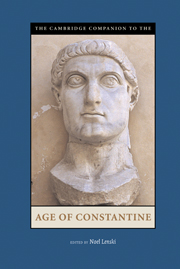Book contents
- Frontmatter
- Introduction
- 1 Sources for the History of Constantine
- Section 1 Politics and Personalities
- 2 Before Constantine
- 3 The Reign of Constantine
- 4 The Dynasty of Constantine Down to 363
- Section II Religion and Spiritual Life
- Section III Law and Society
- Section IV Art and Culture
- Section V Empire and Beyond
- Appendix 1: Stemmata
- Appendix 2: Timeline
- Maps
- Primary Sources and Translations
- Secondary Bibliography
- Index
3 - The Reign of Constantine
from Section 1 - Politics and Personalities
Published online by Cambridge University Press: 28 September 2007
- Frontmatter
- Introduction
- 1 Sources for the History of Constantine
- Section 1 Politics and Personalities
- 2 Before Constantine
- 3 The Reign of Constantine
- 4 The Dynasty of Constantine Down to 363
- Section II Religion and Spiritual Life
- Section III Law and Society
- Section IV Art and Culture
- Section V Empire and Beyond
- Appendix 1: Stemmata
- Appendix 2: Timeline
- Maps
- Primary Sources and Translations
- Secondary Bibliography
- Index
Summary
Birth and Early Career
The details of Constantine’s birth are enigmatic. We know that he was born in or near the Moesian city of Naissus (Ni.s: see Map 1) and that he was the eldest son of Flavius Valerius Constantius, soon to become Caesar. The year of his birth, however, is hardly certain. Most historians agree that he was born on February 27, 272, though one good contemporary source indicates 276, and some scholars have argued for a date as late as 288. Behind much of the confusion stands Constantine himself, who regularly had himself portrayed in art and panegyrics as much younger than he actually was. The question of Constantine’s legitimacy has also long plagued historians. The Christian chronographer Jerome, writing in the 380s, claimed that Constantine’s mother, Helena, was a mere concubine of Constantius I; the anonymous author of the Origo Constantini, a source quite favorable to Constantine, calls Helena “extremely lowly”; and bishop Ambrose, Jerome’s contemporary, reports that she had been a mere stable maid when she met Constantius. Whatever the exact status of their relationship, then, Constantine’s mother was hardly of noble stock, a fact that eventually provoked his father to leave her c. 289 in order to marry the princess Theodora, stepdaughter of the emperor Maximian.
When Constantine was born, his father, a native of Illyricum (the Balkans), was serving as an imperial bodyguard (protector) to the emperor Aurelian (r. 270-5). This position would prove quite favorable after two other Illyrian officers of Aurelian, Diocletian and in turn Maximian, took over corulership of the empire in 284 and 285, respectively (Coins 5 and 7).
- Type
- Chapter
- Information
- The Cambridge Companion to the Age of Constantine , pp. 59 - 90Publisher: Cambridge University PressPrint publication year: 2005
- 14
- Cited by

